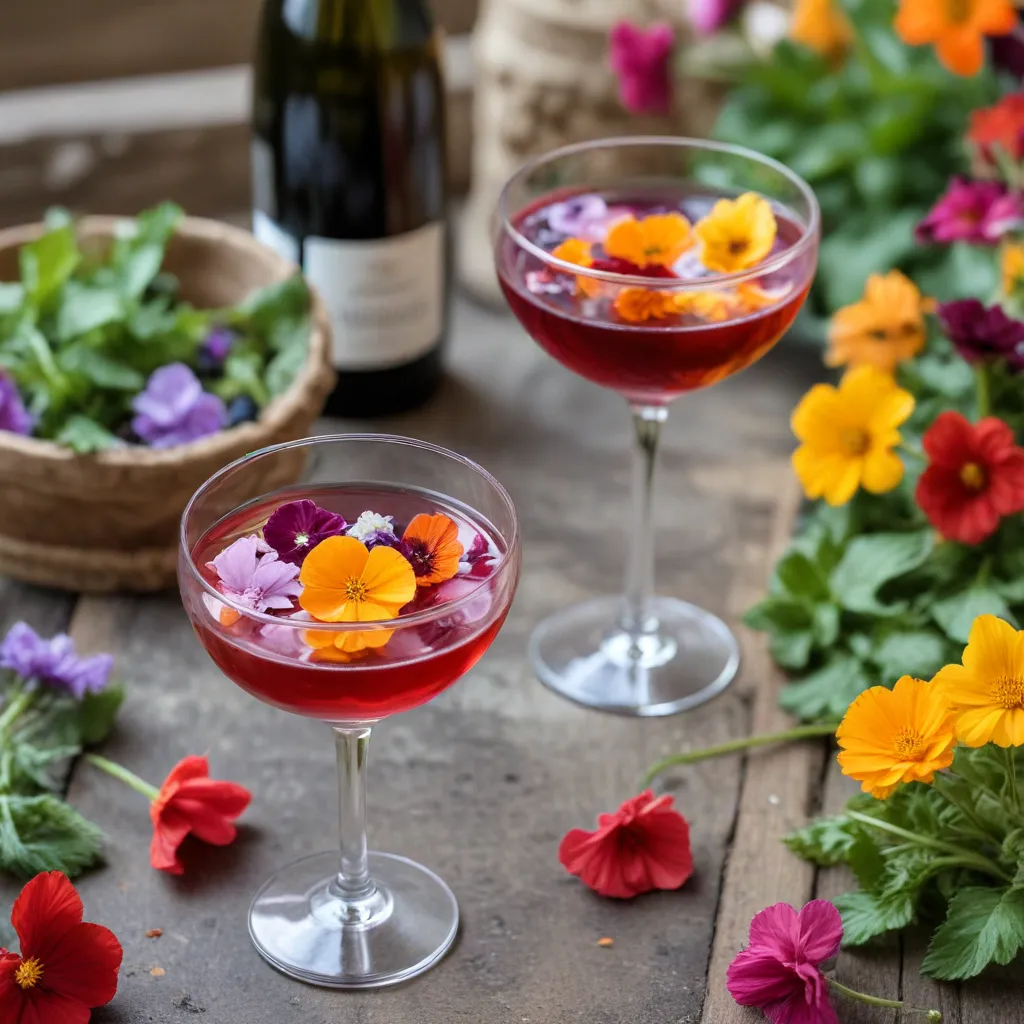
At the Wine Garden Inn, we take great pride in our estate-grown produce and the innovative ways we incorporate it into our culinary offerings. One of our most exciting and versatile ingredients? Edible flowers. These vibrant, aromatic blooms not only make for visually stunning presentations, but they also lend unique and delicate flavors that can elevate both our food and beverage menus.
Edible Flower Cultivation
Flower Selection
Selecting the right edible flowers for your garden is crucial. Some varieties, like roses, pansies, and nasturtiums, are known for their distinct, floral-forward tastes, while others, such as zucchini blossoms and chive flowers, offer more savory, herbaceous notes. We’ve had great success with calendula, lavender, and borage in our own garden, finding that their vibrant hues and complex flavors pair beautifully with our wines.
Flower Harvesting and Preparation
When it comes to harvesting and preparing edible flowers, it’s important to exercise caution. Avoid any blooms that have been treated with pesticides or grown in areas that may have been contaminated. Always thoroughly inspect and rinse your flowers before use. For delicate petals, a gentle pat dry is sufficient, but larger blossoms may benefit from a quick soak and spin in a salad spinner to remove any lingering dirt or bugs.
Flower Infusion Techniques
One of our favorite ways to incorporate edible flowers into our cocktail program is through flower-infused wines. By steeping fresh or dried petals in our estate-grown vintages, we’re able to extract an array of aromatic compounds that lend nuanced, floral notes. We’ve experimented with everything from a fragrant lavender-infused Riesling to a tart and herbaceous sweet woodruff-spiked Gewürztraminer.
Wine Cocktail Recipes
Floral-Infused Wines
To make our floral-infused wines, we simply place a handful of freshly harvested flower petals or a few teaspoons of dried blossoms into a bottle of wine. After allowing the mixture to steep for several hours (or even days, depending on desired intensity), we strain out the plant material, leaving behind a beautifully perfumed, sippable creation.
Flower-Garnished Cocktails
Of course, edible flowers aren’t limited to just our wine program – they also make stunning garnishes for our handcrafted cocktails. A sprig of lavender or a scattered pansy petals can instantly elevate the visual appeal of a drink, while a candied rose petal lends a delicate, sweet crunch. We love experimenting with unexpected flavor pairings, like the bright, citrusy notes of hibiscus against the herbaceous, piney character of our gin.
Pairing Considerations
When it comes to crafting cocktails with edible flowers, it’s all about striking the right balance. We find that the floral aromas and flavors of our wines and spirits can often overpower the more delicate blooms, so we tend to favor heartier, more robust varieties. Nasturtiums, marigolds, and dianthus have become go-to choices for us, as their bold tastes can hold their own against our complex mixology creations.
Flavor Profiles
Aromatic Floral Notes
The wide array of edible flowers available to us means an equally diverse spectrum of flavors. Roses and lavender offer the quintessential floral aroma, with notes of fragrant, perfumed sweetness. Chamomile and elderflower, on the other hand, lend a more herbaceous, almost tea-like quality. And zucchini blossoms or chive flowers bring a savory, onion-y undertone.
Culinary Applications
Beyond just garnishing cocktails, we love incorporating edible flowers into our culinary offerings, as well. Stuffed squash blossoms, floral-infused vinegars, and flower-petal-garnished salads are just a few of the creative ways we showcase these beautiful, delicious blooms. The delicate, ephemeral nature of many edible flowers also makes them a perfect pairing for our estate-grown produce and seasonal menu items.
Sensory Experiences
One of the most captivating things about working with edible flowers is the way they engage all of our senses. The vibrant hues and intricate petals delight the eye, while the varied aromas and flavors stimulate our smell and taste. But perhaps most interestingly, there’s also a distinct textural component – the crunch of a candied pansy or the soft, silky mouthfeel of a rose petal can completely transform a dish or cocktail.
Gardening Essentials
Soil and Climate Requirements
Cultivating a thriving edible flower garden requires a bit of careful consideration when it comes to soil and climate. Many varieties, like lavender and rosemary, prefer well-drained, slightly alkaline conditions, while others, such as pansies and forget-me-nots, thrive in more acidic, moisture-retentive environments. Taking the time to understand the specific needs of your chosen flowers is key to ensuring a bountiful harvest.
Planting and Maintenance
Proper planting and ongoing maintenance are also crucial for edible flower success. Most of our blooms are grown from seed, which we start indoors before transplanting outdoors after the last frost. Regular deadheading, weeding, and watering help to keep our flowers healthy and productive throughout the growing season. And when it comes time to harvest, we always make sure to pick in the morning, when the petals are at their most vibrant and flavorful.
Organic Cultivation Practices
At the Wine Garden Inn, we’re committed to sustainable, organic growing practices across our entire estate. This extends to our edible flower beds, where we eschew harsh chemical pesticides and fertilizers in favor of more natural, earth-friendly methods. Composting, companion planting, and hand-weeding are just a few of the ways we nurture our blooms without compromising their safety for culinary use.
Embracing the cultivation and creative application of edible flowers has been a true labor of love for us here at the Wine Garden Inn. From crafting innovative cocktails to elevating our seasonal menus, these vibrant, flavorful blooms have become an integral part of our hospitality experience. We invite you to visit us and discover the magic of edible flowers for yourself. Cheers!
